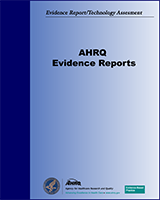NCBI Bookshelf. A service of the National Library of Medicine, National Institutes of Health.
ECRI Health Technology Assessment Group. Diagnosis and Treatment of Swallowing Disorders (Dysphagia) in Acute-Care Stroke Patients. Rockville (MD): Agency for Health Care Policy and Research (US); 1999 Jul. (Evidence Reports/Technology Assessments, No. 8.)
This publication is provided for historical reference only and the information may be out of date.

Diagnosis and Treatment of Swallowing Disorders (Dysphagia) in Acute-Care Stroke Patients.
Show detailsEvidence Table 1. Epidemiology of Dysphagia in the USA
Evidence Table 2. Epidemiology of Stroke in the USA
Evidence Table 3. Epidemiology of Dysphagia in Stroke
Evidence Table 4. Epidemiology of Parkinson's Disease in the USA
Evidence Table 5. Epidemiology of Dysphagia in Parkinson's Disease
Evidence Table 6. Epidemiology of Alzheimer's Disease in the USA
Evidence Table 7. Epidemiology of Dysphagia in Alzheimer's Disease
Evidence Table 8. Epidemiology of Other Neurological Disorders in the USA
Evidence Table 9. Epidemiology of Dysphagia in Other Neurological Disorders
Evidence Table 10. Stroke Patients with Dysphagia who Become Malnourished
Evidence Table 11. Cases of Neurologic Dysphagia that Present with Aspiration
Evidence Table 12. Cases of Stroke that Present with Aspiration
Evidence Table 13. Cases of Stroke that Result in Pneumonia
Evidence Table 14. Cases of Aspiration that Result in Pneumonia
Evidence Table 15. Comparison of Aspirators, Nonaspirators, and Dysphagics in Pneumonia Incidence
Evidence Table 16. Cases of Dysphagia that Lead to Pneumonia
Evidence Table 17. Cases of Nondysphagic Stroke that Result in Pneumonia
Evidence Table 18. Cases of Nonaspirating Dysphagia that Result in Pneumonia
Evidence Table 19. Cases of Aspiration that Lead to Pneumonia Death
Evidence Table 20. Patients with Pneumonia who Die of Pneumonia
Evidence Table 21. Cases of Pneumonia that Result in Death (all causes) in Elderly Patients
Evidence Table 22. Stroke Patients Without Pneumonia who Died
Evidence Table 23. Annual Incidence of Pneumonia in the Elderly
Evidence Table 30. Applied Diagnosis to Guide Treatment: Diet Modification
Evidence Table 31. Applied Diagnosis to Guide Treatment: Postural Changes
Evidence Table 32. Applied Diagnosis to Guide Treatment: Other Treatments
Evidence Table 33. Clinical Oropharyngeal Signs and Symptoms for Prediction of Pneumonia
Evidence Table 38. Clinical (noninstrumented) Exam Detection of Aspiration in all Stroke Patients
Evidence Table 39. MBS Interobserver Variability of Diagnosis of Aspiration
Evidence Table 40. Comparison of BSE and VFSS for Prediction of Aspiration Pneumonia
Evidence Table 41. Pneumonia Predicted by Apparent Unsafe Swallow at BSE
Evidence Table 42. Pneumonia Predicted by Aspiration at MBS
Evidence Table 45. Comparison of Fiberoptic Endoscopy to MBS for Detection of Aspiration
Evidence Table 47. Noninvasive Swallow Therapies. Outcome: Feeding Method (Link T1 to O3)
Evidence Table 50. Feeding Tubes. Outcome: Weight Change (Link T4 to O4)
Evidence Table 51. Noninvasive Swallow Therapies. Outcome: Aspiration (Link T1 to O5)
Evidence Table 52. Diet Modification. Outcome: Aspiration (Link T2 to O5)
Evidence Table 53. Swallow Therapy and Diet Modification. Outcome: Aspiration (Link T3 to O5)
Evidence Table 54. Feeding Tubes. Outcome: Aspiration (Link T4 to O5)
Evidence Table 55. Feeding Tubes. Outcome: Tube Complications (Link T4 to O6)
Evidence Table 56. Noninvasive Swallow Therapies. Outcome: Pneumonia (Link T1 to M1)
Evidence Table 57. Diet Modification. Outcome: Pneumonia (Link T2 to M1)
Evidence Table 58. Swallow Therapy and Diet Modification. Outcome: Pneumonia (Link T3 to M1)
Evidence Table 59. Feeding tubes. Outcome: Pneumonia (Link T4 to M1)
Evidence Table 60. Diet Modification. Outcome: Malnutrition/Wasting (Link T2 to M2)
Evidence Table 61. Feeding Tubes. Outcome: Major Tube Complications (Link T4 to M4)
Evidence Table 62. Feeding Tubes. Outcome: QOL (Link T4 to O7)
Evidence Table 63. Noninvasive Swallow Therapy. Outcome: Mortality (Link T1 to O8, O9)
Evidence Table 64. Diet Modification. Outcome: Mortality (Link T2 to O8, O9)
Evidence Table 68. Feeding Tubes. Outcome: Mortality from Treatment (Link T4 to O10)
- Evidence Tables - Diagnosis and Treatment of Swallowing Disorders (Dysphagia) in...Evidence Tables - Diagnosis and Treatment of Swallowing Disorders (Dysphagia) in Acute-Care Stroke Patients
Your browsing activity is empty.
Activity recording is turned off.
See more...